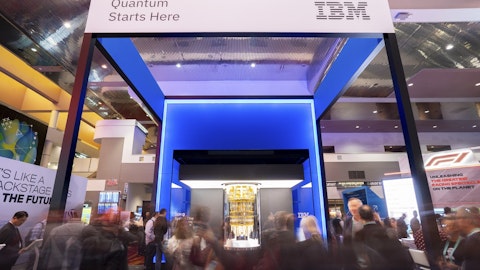Unidentified Analyst: Hi. Thanks so much for taking my questions. This is Stephen calling on behalf of Krish. Subodh, maybe first one for you. Just kind of going back to the NQCC win and sort of the deployment timing. I know you mentioned that, that facility will be up and running later this year and start the deployment of the system around that time. But just curious in terms of when the procurement and installation of your — whether it’s the QPU or a number of subcomponents that goes into their system. Can you talk about when that approximate timing might be? Is it late this year? Or is it potentially into early next year? And also, just more broadly, you referenced other initiatives in other countries that might still be early. Is the NQCC’s time line in terms of building out and potentially installing it, is that a good template for future kind of installments or buildouts by other countries?
Subodh Kulkarni: Yes. Thanks, Krish. So certainly, the NQCC time line that they have provided us is more gated by their facility rather than our ability to supply the QPU. We already have started ordering several subcomponents, and we already have the chip and the core products are already ready basically. So we are working with them right now on the facility side to make sure that the facility is done once it comes up. Having said all that, the target right now is middle of this year, sometime in the June through August time period is when the facility will be ready. It will take us a few weeks, maybe a month or so to get it delivered and installed properly and then probably another month of debugging also. So before — well before the end of this year, the system should be up and running.
That’s the overall time line. As we discussed with other national labs in other countries. This model that NQCC is doing is seems to be a replicable model, if you will, and other countries are looking along the same lines where they want 20-odd qubit system to start. 9-qubit is a good starting point, but it’s really for basic research applications. 28-plus qubits gives you enough horsepower to do some real computations work. So many national labs that we are talking to right now are talking about 20-plus systems. There are a couple that are about 80-plus cubit systems, too. Those are the more aggressive ones. Obviously, the price points will be higher. So our hope is that besides NQCC, we will get at least one more, maybe a couple more national labs this year, of different countries using the 20-plus qubit system and then hopefully some early work starts with some 80-plus qubit systems that may get installed early next year or middle of next year.
But again, really, the focus is all mostly on fidelity. As fidelity improves, all these opportunities will continue to happen.
Unidentified Analyst: Got it. Got it. That’s very helpful. And also, in terms of the Novera QPU, very exciting to see the formalized program and marketing for that. From some of the details that you’ve published so far, and it seems like the pricing for that is just under $1 million, but just kind of curious like are you only selling standard versions? Or is there opportunities for more bespoke configurations and what that — would you be able to talk about is sort of the rough ASP revenue that could be associated with more bespoke designs? And lastly, in terms of the product lead time or backlog, is it still sort of intra-quarter type orders that get fulfilled pretty quickly? Or is there a longer backlog or a lead time associated with Novera?
Subodh Kulkarni: Regarding Novera, I mean, the product is fairly simple. I mean our product is essentially for 900K. We will ship you a basic QPU that can essentially become a plug and play modules into your dilution refrigeration systems. Our baseline assumption is that the customer already has a DR in their facility, are familiar with quantum computing in general, so they can just take our QPU and plug it into their DR. That’s the whole concept of Novera. And they can — we have all of the parts ready and we literally keep one or two in stock right now. So if an order comes tomorrow, we can ship it within a day practically. And it’s fairly straightforward to get it integrated and up and running for a customer who’s familiar with quantum computing and dilution refrigerations.
So it’s a fairly straightforward product sale, if you will, get the order. Ship the standardized QPU that goes directly into the system. There’s three dilution refrigeration companies that are generally available in the world right now, Blue Force, a Finnish company, Oxford Instruments from UK, FormFactor from California. And then a couple of other smaller companies are getting into the business. Each one has a slightly different consideration of their DR. So depending on the exact model and which — what the customer has, it may need some customization, but our plan is to try to keep it as an off-the-shelf standard product that we can ship quickly, that will plug into your existing DR. But there are some DRs that may not be suitable to do a plug and play, in which case, we may have to do some adjustments or they may have to do adjustment on the customer side.




